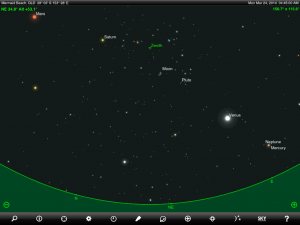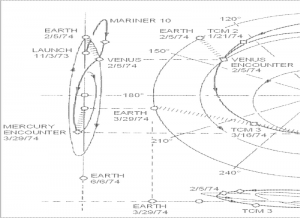Posted 23 March 2014 This post is biased towards events that can be seen with the unaided eye or via the Internet. It also can only cover predictable events. Random events such as asteroid impacts won’t be listed. Where events are time specific, I have listed the events in AEST (Australian Eastern Standard Time) and AEDT (Australian Eastern Daylight Time).
Planets: Jupiter will continue to be prominent as the brightest ‘star’ in the early evening sky. Look low above the North Western horizon at the end of evening twilight to locate it. Mars is now only weeks from its 2014 opposition (useful information on the 9 April 2014 opposition here and here) and is now visible low above the Eastern horizon after 7 pm AEST / 8 pm AEDT. Note that as Earth and Mars draw closer, Mars will continue to become noticeably brighter. Saturn rises just after 8:20 pm AEST / 9:20 pm AEDT. As for Mars, look for Saturn low on the Eastern horizon.
Venus is the brightest ‘star’ in the morning twilight sky. To locate Venus, look above the Eastern horizon as the sky brightens. Mercury is visible in the morning twilight sky low above the Eastern horizon (closer to the horizon than Venus). Mercury rises around 4:10 am AEST / 5:10 am AEDT mid-week. If you haven’t seen Mercury, it will be much easier to see at a more convenient time in the evening twilight sky later this year (September and October 2014). Neptune is now visible in the morning sky but remains too low on the horizon as the sky brightens for practical viewing.
Uranus is located close to the Sun and therefore not visible.
International Space Station: The International Space Station is visible low in the evening sky this week for Canberra, Australia over the period 24 – 28 March 2014. Information on passes for Canberra (with links to finder charts) can be found here. Go here for satellite viewing information / predictions for all Australian locations.

24 March 2014: Minor planet Pallas stationary
24 March 2014: 11:46 am AEST / 12:46 pm AEDT Last Quarter Moon
Friday 28 March 2014: 5 am AEST / 6 am AEDT Moon at perigee (closest point to the Earth in its orbit at 365,703 km)
Friday 28 March 2014: Slim crescent Moon will be located below Venus. Morning predawn sky.
Saturday 29 March 2014: 40th anniversary of the first (brief) visit to the planet Mercury by a robotic spacecraft. Mariner 10 performed a flyby of Mercury on this date in 1974.
